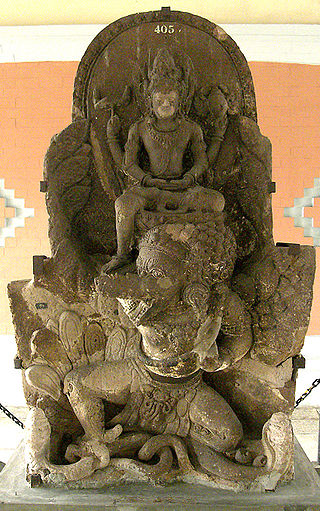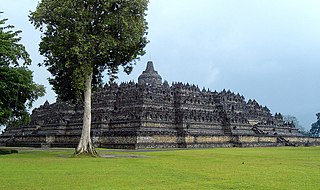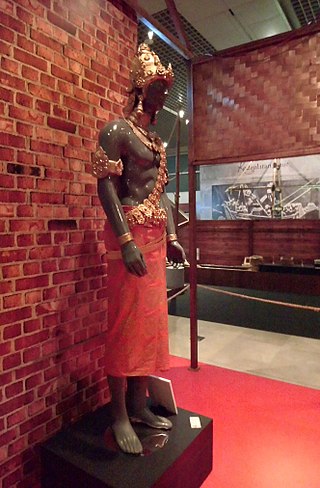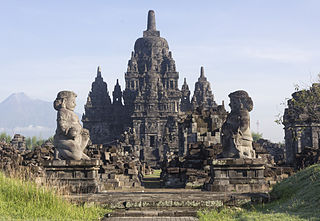Related Research Articles

Srivijaya, also spelled Sri Vijaya, was a Buddhist thalassocratic empire based on the island of Sumatra that influenced much of Southeast Asia. Srivijaya was an important centre for the expansion of Buddhism from the 7th to 11th century AD. Srivijaya was the first polity to dominate much of western Maritime Southeast Asia. Due to its location, Srivijaya developed complex technology utilizing maritime resources. In addition, its economy became progressively reliant on the booming trade in the region, thus transforming it into a prestige goods-based economy.

Prambanan is a 9th-century Hindu temple compound in the Special Region of Yogyakarta, in southern Java, Indonesia, dedicated to the Trimūrti, the expression of God as the Creator (Brahma), the Preserver (Vishnu) and the Destroyer (Shiva). The temple compound is located approximately 17 kilometres (11 mi) northeast of the city of Yogyakarta on the boundary between Central Java and Yogyakarta provinces.

The Shailendra dynasty was the name of a notable Indianised dynasty that emerged in 8th-century Java, whose reign signified a cultural renaissance in the region. The Shailendras were active promoters of Mahayana Buddhism and covered the Kedu Plain of Central Java with Buddhist monuments, one of which is the colossal stupa of Borobudur, now a UNESCO World Heritage Site.

The Mataram Kingdom ; also known as Medang Kingdom was a Javanese Hindu kingdom that flourished between the 8th and 11th centuries. It was based in Central Java, and later in East Java. Established by King Sanjaya, the kingdom was ruled by the Shailendra dynasty and Ishana dynasty.

The Sanjaya dynasty was a Javanese dynasty which ruled the Mataram Kingdom in Java during the first millennium CE. The dynasty promoted Hinduism on the island.

Airlangga, regnal name Rakai Halu Sri Lokeswara Dharmawangsa Airlangga Anantawikramottunggadewa, was the only king of the Kingdom of Kahuripan.

Ratu Boko or Ratu Boko Palace is an archaeological site in Java. Ratu Boko is located on a plateau, about three kilometres south of Prambanan temple complex in Yogyakarta, Indonesia. The original name of this site is still unclear, however the local inhabitants named this site after King Boko, the legendary king mentioned in Roro Jonggrang folklore. In Javanese, Ratu Boko means "Stork King".

Samaratungga was the head of the Sailendra dynasty which ruled the Mataram Kingdom and Srivijaya in the 8th and 9th centuries. He was the successor of King Indra, and his name was mentioned in the Karangtengah inscription dated 824 CE as the constructor of a sacred Buddhist building called Venuvana to place the cremated ashes of his predecessor King Indra of Sailendra. During his administration, he initiated the construction of a massive Buddhist monument Borobudur. Samaratungga married Dewi Tara, the princess of Srivijayan ruler Dharmasetu, which created a close political alliance between the Sailendras and Srivijaya.

Sanjaya was the founder of the Mataram Kingdom during the 8th century. His name was carved in the Sanskrit Canggal inscription which was found at the Gunung Wukir temple that stood on Wukir or Ukir hill on the southern Kedu Plain in Central Java.

Candi Plaosan, also known as the Plaosan Complex, is one of the Buddhist temples located in Bugisan village, Prambanan district, Klaten Regency, Central Java, Indonesia, about 1 kilometre to the northeast of the renowned Hindu Prambanan Temple.

Balaputradewa was the maharaja of Srivijaya in the 9th century CE as well as the former head of the Sailendra dynasty. He was the youngest son of the preceding Sailendran maharaja, Samaratunga, through marriage with Dewi Tara who was in turn the daughter of another maharaja, Dharmasetu of Srivijaya.
Balitung was a Javanese king of Mataram. Balitung was his birth name, though like other Javanese kings of this period, he was commonly referred to by his appanage title Rakai Watukura. He reigned from 10 May 898 to c. 911–912. His territories included a wide range of areas in Central Java and East Java.

Sewu is an eighth-century Mahayana Buddhist temple located 800 metres north of Prambanan in Central Java, Indonesia. The word for a Hindu or Buddhist temple in Indonesian is "candi", hence the common name is "Candi Sewu". Candi Sewu is the second largest Buddhist temple complex in Indonesia; Borobudur is the largest. Sewu predates near the "Loro Jonggrang" temple at Prambanan. Although the complex consists of 249 temples, this Javanese name translates to 'a thousand temples,' which originated from popular local folklore. Archaeologists believe the original name for the temple compound to be Manjusrigrha.

The Legend of Roro Jonggrang is a Javanese popular legend (folktales) from Central Java telling the story of love and betrayal, the warrior and the cursed princess. It also explains the mythical origin of Ratu Boko palace, Sewu temple, and the Durga statue in Prambanan temple compound. The title Roro is an ancient honorific title to address unmarried princesses and female nobility, thus the name Rara Jonggrang in Javanese means 'slender maiden'.

Pramodhawardhani was the queen consort of King Rakai Pikatan of Mataram Kingdom in 9th century Central Java. She was the daughter of Sailendran king Samaratungga.
The Mantyasih inscription is an important inscription found and kept by Li Djok Ban in Ngadireja Parakan Temanggung, then the inscription was brought by one of the princes of Surakarta to brought to Surakarta and is now stored in the Radyapustaka Museum, Central Java, Indonesia. It is dated to 907 and was created by King Balitung from the Sanjaya dynasty, of the Ancient Mataram Kingdom. This inscription contains a genealogy of the kings of Mataram before King Balitung.
Karangtengah inscription is the inscription written on five pieces of stones dated 746 Saka or 824 CE, discovered in Karangtengah hamlet, Temanggung Regency, Central Java, Indonesia. The inscription was written in ancient Javanese script in two languages; Old Javanese and Sanskrit. Lines 1-24 were written in Sanskrit, and the rest of the lines were written in old Javanese. The inscription is linked with the temples Borobudur and Mendut.

The Shivagrha inscription is an inscription from the Mataram Kingdom of Central Java, dated in chandrasengkala (chronogram) ”Wwalung Gunung sang wiku”, that is, the year 856 CE. The inscription was inscribed by order of Dyah Lokapala right after the end of Rakai Pikatan's reign and gave a detailed description of a grand temple compound dedicated to Shiva called Shivagrha, corresponding to the Prambanan temple compound.

Balaputradeva Museum, officially the State Museum of South Sumatra Province "Balaputradeva", is an ethnographic museum located in Southern Sumatra's capital Palembang. The museum is the state museum of the Province of South Sumatra. The name Balaputradeva is derived from Balaputra, a 9th century sovereign of Srivijaya kingdom and the former head of the Sailendra dynasty whose main center was located in the vicinity of Palembang. Balaputradeva Museum displays the history and traditions of the province of South Sumatra.

Śrī Mahārāja Rakai Kayuwangi Dyah Lokapāla Śrī Sajjanotsavatuṅga was the seventh monarch of the Mataram Kingdom of Central Java period who ruled between 855 and 885. His birthname was Lokapāla, as indicated by the title dyah or pu that precedes it. He was also commonly referred to by his appanage title Rakai Kayuwangi, which means 'Lord of Kayuwangi'. King Lokapāla was described as a valiant king who defeated his enemies.
References
- ↑ Coedès, George (1968). Walter F. Vella (ed.). The Indianized States of Southeast Asia. trans.Susan Brown Cowing. University of Hawaii Press. ISBN 978-0-8248-0368-1.
- Marwati Poesponegoro & Nugroho Notosusanto. 1990. Sejarah Nasional Indonesia Jilid II. Jakarta: Balai Pustaka